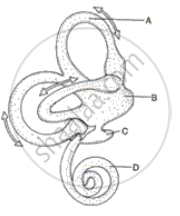Advertisements
Advertisements
Question
Categorise the following parts under (i) external, (ii) middle and (iii) internal ear.
Ear drum, hammer, pinna, cochlea, anvil, stirrup, eustachian tube, tympanum, oval window, semi-circular canals.
Solution
- External ear: Pinna, Tympanum, Ear drum.
- Middle ear: Hammer, anvil, stirrup, Eustachian tube, oval window.
- Internal ear: Semi-circular canals, Cochlea.
RELATED QUESTIONS
Write short notes on the following Ear ossicles
Answer the following:
Which part of the ear determines the pitch of a sound?
For human ears, the audible range is 20 Hz to 20,000 Hz.
Given in the box below are a set of 14 biological terms. Of these, 12 can be paired into 6 matching pairs. Out of the six pairs, one has been done for you as an example.
Example : endosmosis - Turgid cell.
Identify the remaining five matching pairs :
| Cushing’s syndrome, Turgid cell, Iris, Free of rod and cone cells, Colour of eyes, Hypoglycemia, Active transport, Acrosome, Addison’s disease, Blind spot, Hyperglycemia, Spermatozoa, Endosmosis, Clotting of blood. |
Name the following:
The ear ossicle attached to the tympanum.
Differentiate between members of the following pair with reference to what is asked in bracket.
Semi-circular canal and cochlea (Senses perceived)
Mention, where in living organism is the following located and state their main function:
Organ of corti
Where is the Semicircular canals located? Briefly mention its function.
Draw a neat and labelled diagram of the human ear. With the help of this diagram, explain the construction and working of the human ear.
Name the following:
Part of internal ear related to balance.
The diagram alongside represents the structure found in the inner ear. Study the same and then answer the questions that follow:
(i) Name the parts labelled A, B, C and D.
(ii) Name the parts of the ear responsible for transmitting impulses to the brain.
(iii) Name the part labelled above which is responsible for:
1. Static equilibrium. 2. Dynamic equilibrium. 3. Hearing
(iv) Name the audio receptor cells which pick up vibrations.
(v) Name the fluid present in the inner ear.

Choose the correct answer.
Labyrinth is a part of ____________
The figure below is the sectional view of a part of the skull showing a sense organ:

Name the part labeled 'tm'. What is its function?
Mention, if the following statement is True or False
Cochlea of the ear is concerned with the sense of balance.
Select the CORRECT match of part of the human ear and its function.
The eardrum is known as ______.
The spiral organ possessing sensory cells for hearing is ______.
Where are the following located?
Eustachian canal
With reference to human ear answer the question that follow:
Name the part of the ear associated with dynamic balance.
With reference to human ear answer the question that follow:
Name the part of the ear associated with the amplification of vibrations.
